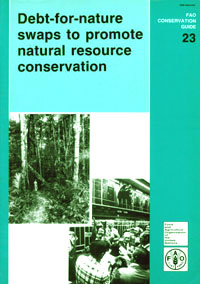
by
Carlos A. Quesada Mateo
FAO CONSERVATION GUIDE 23
FOOD AND AGRICULTURE ORGANIZATION OF THE UNITED NATIONS
Rome, 1993

2. THE EXTERNAL DEBT OF DEVELOPING COUNTRIES
2.1 Background
2.2 The emergence of the external debt secondary market
2.3 The debt-for-nature swap initiative
2.4 The operational framework for debt-for-nature swaps
2.5 Advantages and drawbacks of the conversion process
3.1 General conditions for swaps using commercial debts
3.2 Case studies in Latin America, Asia and Africa
3.2.1 Argentina
3.2.2 Bolivia
3.2.3 Costa Rica
3.2.4 Ecuador
3.2.5 Dominican Republic
3.2.6 Madagascar
3.2.7 Philippines
3.2.8 General summary
4. INDUSTRIALIZED COUNTRIES AND EXTERNAL DEBT SWAPS
5. SWAP PROSPECTS IN DEVELOPING COUNTRIES
5.1 Bilateral debt and the role of development banks
5.2 General recommendations to development cooperation agencies
Working group conclusions and recommendations at the Workshop on Debt-for-Nature Swaps (Santiago, Chile, 3-5 December 1991)

